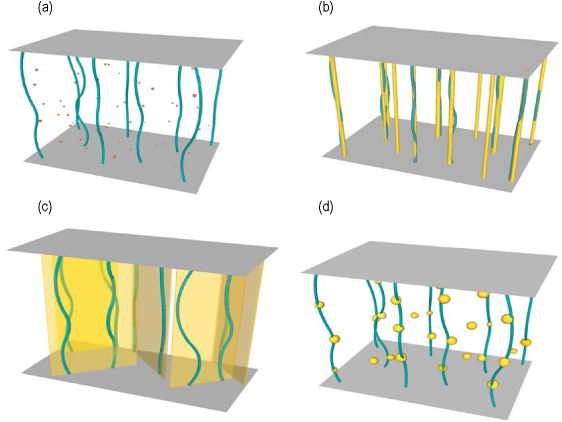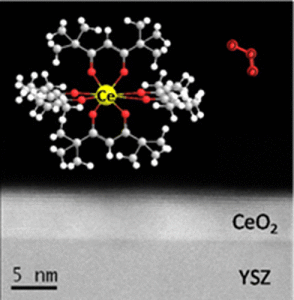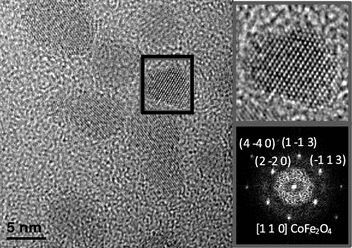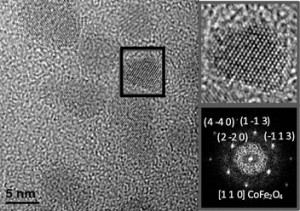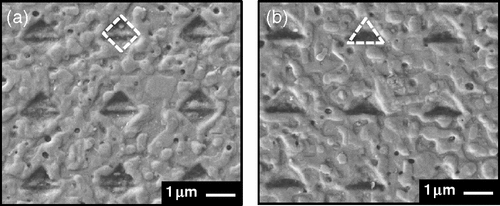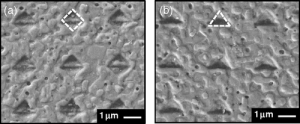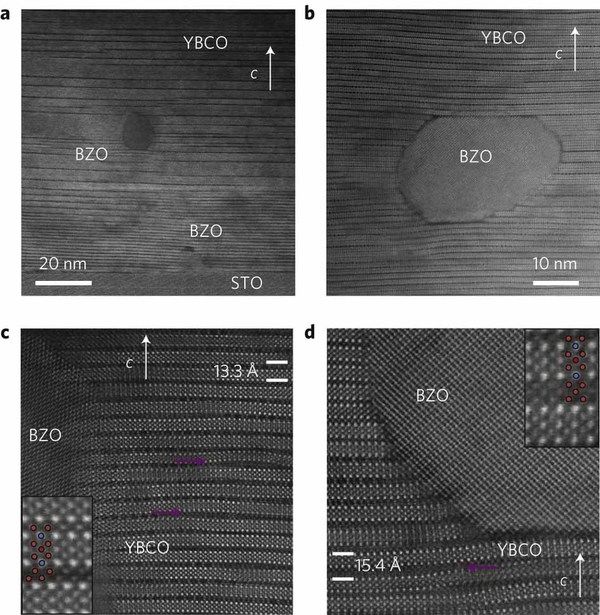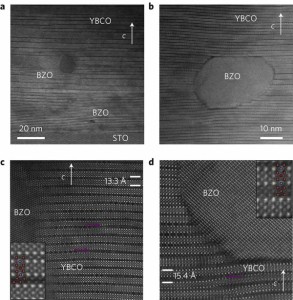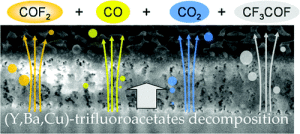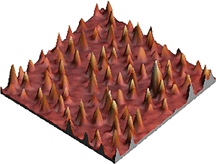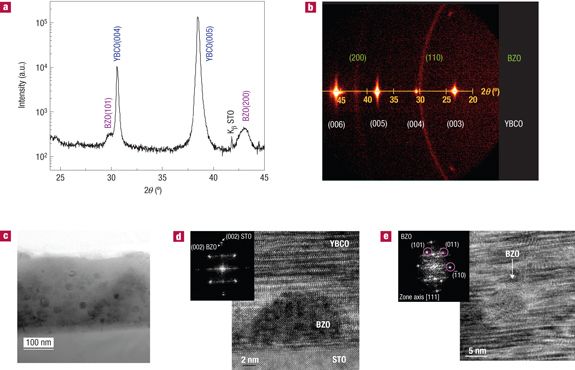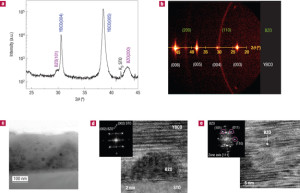
J. Gazquez, F. Sandiumenge, M. Coll, A. Pomar, N. Mestres, T. Puig, X. Obradors, Y. Kihn, M. J. Casanove and C. Ballesteros
Chem. Mat. 18, 6211-6219 (2006)
DOI:
10.1021/cm0617891
We describe the conversion of yttrium, barium, and copper trifluoracetate-derived solid precursors to epitaxial YBa
2Cu
3O
x superconducting ceramics on (001)-oriented LaAlO
3substrates. Transmission electron microscopy, electron energy loss spectroscopy, energy-dispersive X-ray analysis, and X-ray diffraction are used to characterize the reaction path and nucleation mechanism yielding high critical current YBa
2Cu
3O
7. Our results show that the pyrolysis of the trifluoracetate solutions yields a nanostructured, partially amorphous Ba
1-xY
xF
2+x matrix having a Ba/Y ratio close to 2, with homogeneously dispersed CuO nanoparticles. Upon heating, the chemical trajectory of the fluoride matrix and the overall microstructural evolution of the ceramic precursor prior to YBa
2Cu
3O
7 nucleation is driven by the decomposition and oxidation of this solid solution. The Y solid solubility decreases with temperature yielding Y
2O
3 which reacts with the CuO particles forming Y
2Cu
2O
5 at about 700 °C. In addition, electron energy loss spectroscopy reveals a high oxygen concentration and almost no Y in the matrix quenched from 795 °C, at a stage where the YBa
2Cu
3O
x phase still forms disconnected 50−100 nm thick islands spaced by 1−2 μm. The observed evolution from Ba
1-xY
xF
2+x to a barium oxyfluoride mostly occurs prior to the heteroepitaxial nucleation of YBa
2Cu
3O
x at about 700 °C. Hence, a microstructural scenario is defined which favors competitive nucleation growth between heteroepitaxial YBa
2Cu
3O
x and bulk Y
2Cu
2O
5. X-ray diffraction pole-figure analysis reveals that the oxyfluoride phase is heavily textured, exhibiting two epitaxial relationships with the (001)-LaAlO
3 substrate: (001)OF//(001)LaAlO
3, [110]OF//[100]LaAlO
3 and (111)OF//(001)LaAlO
3, [110]OF//[100]LaAlO
3 (OF stands for oxyfluoride). High-resolution observations of the growth front support that (111)-oriented oxyfluoride regions provide low-barrier nucleation sites for
c-axis-oriented YBa
2Cu
3O
x on the buried (001)-LaAlO
3 substrate. However, owing to its high mismatch, this orientation only represents roughly 15% percent of the total OF volume. Considering that the nucleation of YBa
2Cu
3O
x is confined to those regions, this would lead to an anomalously large internuclei spacing, as is indeed observed, favoring the formation of large YBa
2Cu
3O
x grains and films with a low mosaic spread.
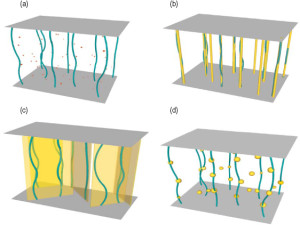 X. Obradors, T. Puig Molina, S. Ricart, M. Coll Bau, J. Gazquez Alabart, A. Palau Masoliver and X. Granados
Superconductor Science and Technology 25, 123001 (2012)
DOI: 10.1088/0953-2048/25/12/123001
Chemical solution deposition (CSD) is a very competitive technique to obtain epitaxial films and multilayers of high quality with controlled nanostructures. Based on the strong attractiveness from the cost point of view, the production of long length coated conductors based on the CSD approach is being extensively developed. The trifluoroacetate route (TFA) is the most widely used route to achieve epitaxial YBa2Cu3O7 (YBCO) layers with high critical currents, however a deep understanding of all the individual consecutive processing steps, as well as their mutual influence and relationship, is required to achieve superconducting materials with high performance. In this work, we review advances in the knowledge of all the steps relevant to the preparation of YBCO thin films based on TFA precursors as a CSD methodology: solution preparation and deposition, pyrolysis processes, intermediate phase evolution, nucleation and growth phenomena, microstructural evolution and its influence on percolating supercurrents, as well as vortex pinning by natural existing defects. Finally, we discuss the open issues still existing in the TFA approach, particularly that of film nanostructuration, and we provide a future outlook for this outstanding methodology.
X. Obradors, T. Puig Molina, S. Ricart, M. Coll Bau, J. Gazquez Alabart, A. Palau Masoliver and X. Granados
Superconductor Science and Technology 25, 123001 (2012)
DOI: 10.1088/0953-2048/25/12/123001
Chemical solution deposition (CSD) is a very competitive technique to obtain epitaxial films and multilayers of high quality with controlled nanostructures. Based on the strong attractiveness from the cost point of view, the production of long length coated conductors based on the CSD approach is being extensively developed. The trifluoroacetate route (TFA) is the most widely used route to achieve epitaxial YBa2Cu3O7 (YBCO) layers with high critical currents, however a deep understanding of all the individual consecutive processing steps, as well as their mutual influence and relationship, is required to achieve superconducting materials with high performance. In this work, we review advances in the knowledge of all the steps relevant to the preparation of YBCO thin films based on TFA precursors as a CSD methodology: solution preparation and deposition, pyrolysis processes, intermediate phase evolution, nucleation and growth phenomena, microstructural evolution and its influence on percolating supercurrents, as well as vortex pinning by natural existing defects. Finally, we discuss the open issues still existing in the TFA approach, particularly that of film nanostructuration, and we provide a future outlook for this outstanding methodology.
